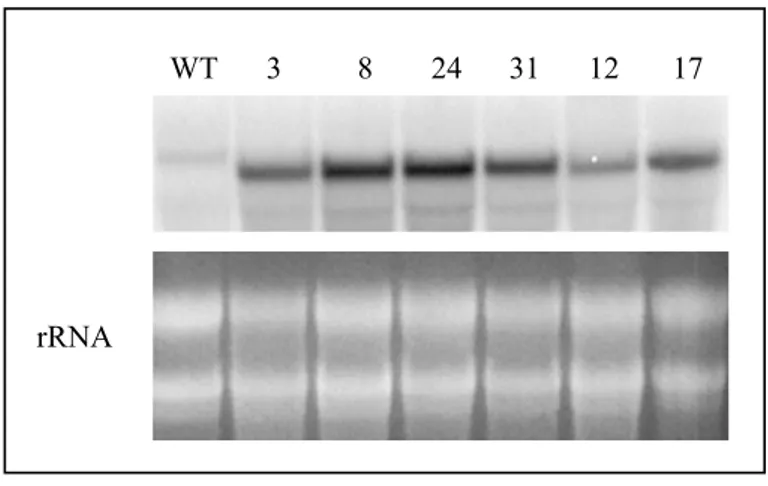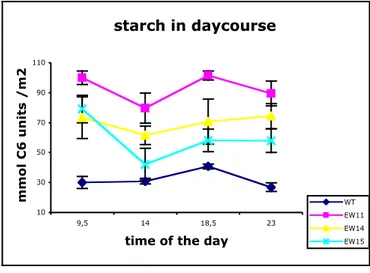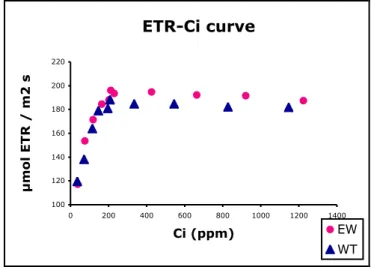overexpressing plastidic transporters involved in starch metabolism
Inaugural-Dissertation zur
Erlangung des Doktorgrades
der Mathematisch-Naturwissenschaftlichen Fakultät der Universität zu Köln
vorgelegt von
Lizhi Zhang
aus Hebei Provinz, China
Köln 2005
Prof. Dr. S. Waffenschmidt
Tag der letzten mündlichen Prüfung: 07. 12. 2005
CONTENTS
1. INTRODUCTION……….. 1
1.1. History of the cultivated potato……… 1
1.2. Taxonomy and characteristics of potato………... 1
1.3. Importance of potato……… 2
1.4. Metabolic pathway relevant to starch synthesis………... 2
1.5. Starch degradation……… 6
1.6. Transgenic plants……….. 7
1.6.1. Genetic modification (GM) technology………. 7
1.6.2. Methods of transformation………. 8
1.6.3. Transgenic potato plants………. 8
1.7. Promoters………. 9
1.7.1. Cauliflower mosaic virus 35S (CaMV 35S) promoter…………... 9
1.7.2. Patatin promoter B33………. 9
1.7.3. Bidirectionalization of polar promoters………. 10
1.8. Plastidic translocators………... 10
1.8.1. Phosphate translocators……….. 11
1.8.1.1. Glucose 6-phosphate/phosphate translocator (GPT)………… 11
1.8.2. Plastidic ATP/ADP translocator (NTT)……….. 12
1.9. Outline of the thesis………. 13
2. MATERIALS AND METHODS……….. 14
2.1. Materials………... 14
2.1.1. Chemicals and Enzymes………. 14
2.1.2. Commercial Kits……… 14
2.1.3. Plant material……… 14
2.1.4. Bacterial strains and cloning vectors……….. 15
2.1.5. Primers………... 15
2.1.6. Media……….. 17
2.1.7. Buffers and Solutions………. 18
2.2. Methods……… 19
2.2.1. DNA extraction from agarose……… 19
2.2.2. Plasmid DNA extraction from E.coli……….. 19
2.2.3. Nucleic acid manipulation……….. 20
2.2.3.1. A-tailing of PCR products……… 20
2.2.3.2. Dephosphorylation……… 21
2.2.3.3. Ligation………. 21
2.2.4. Transformation………... 22
2.2.4.1. Transformation of E.coli………... 22
2.2.4.1.1. Preparation of TSS-competent host cells……….. 22
2.2.4.1.2. Transformation……….. 22
2.2.4.1.3. Screening………... 23
2.2.4.2. Transformation of A. tumefaciens………. 23
2.2.4.2.1. Preparation of electro-competent cells……….. 23
2.2.4.2.2. Transformation……….. 24
2.2.4.3. Transformation and regeneration of transgenic potato plants.. 24
2.2.5. Plant growth conditions……… 26
2.2.6. Isolation of plant genomic DNA for PCR……….. 26
2.2.7. Isolation of plant total RNA………... 27
2.2.7.1. Isolation of total RNA from potato leaves……… 27
2.2.7.2. Isolation of total RNA from potato tubers……… 28
2.2.8. Concentration measurement of DNA and RNA………. 28
2.2.9. PCR amplification analysis……… 28
2.2.9.1. PCR amplification of plasmid DNA………. 28
2.2.9.2. PCR amplification assays of transformed plants……….. 29
2.2.10. Reverse transcription PCR amplification analysis……….. 29
2.2.10.1. Reverse transcription……… 29
2.2.10.2. PCR amplification……… 30
2.2.11. RNA Northern blot analysis……… 30
2.2.12. Radioactive labeling of DNA probes………... 31
2.2.13. Extraction and measurement of potato tubers’ starch, sugar and phosphorylated intermediates………... 32
2.2.13.1. Extraction and measurement of potato tubers’ starch……….. 32
2.2.13.2. Extraction and measurement of potato tubers’ sugar………... 33
2.2.13.3. Extraction and measurement of potato leaves’ sugar and
starch………. 34
2.2.14. Measurement of transporters’ activities……….. 37
2.2.14.1. Measurement of glucose-6-phosphate/phosphate transloctor’s activity……….. 37
2.2.14.1.1. Purification of phospholipids………. 37
2.2.14.1.2. Preparation of liposomes……… 38
2.2.14.1.3. Extraction of proteins and preparation of proteoliposomes……….. 38
2.2.14.1.4. Transport experiment………. 39
2.2.14.2. Measurement of ATP/ADP translocator’s activity……….. 40
2.2.14.2.1. Extraction of proteins and preparation of proteoliposomes……….. 40
2.2.14.2.2. Transport experiment……….. 41
2.2.15.
14CO
2feeding experiments……….. 41
2.2.16. Photosynthesis measurement………... 42
2.2.17. Histochemical detection of GUS activity……… 42
3. RESULTS……… 44
3.1. Comparison of the starch content in tubers of different size………… 44
3.2. Comparison of the expression level of an introduced gene in transgenic potato tubers of different size... 44
3.3. Overexpression of AtNTT using the patatin promoter B33 in potato plants (BA)………... 45
3.3.1. Cloning of the AtNTT into the B33-pBin19 vector………. 45
3.3.2. Analysis of AtNTT expression levels in potato tubers of BA plants……… 46
3.3.3. Analysis of BA tuber yield……….. 47
3.3.4. Analysis of starch and soluble sugar content in tubers of BA plants……… 47
3.3.5. Determination of phosphorylated intermediates in tubers of BA plants……… 48
3.4. Overexpression of pea GPT using the CaMV 35S promoter in potato plants (EW)………... 49
3.4.1. Analysis of pea GPT expression levels in EW plants…………. 49
3.4.2. Expression analysis of potato endogenous GPTs in tubers of EW plants………. 50
3.4.3. Time course of starch and soluble sugar content in leaves of EW plants………. 51
3.4.4. Time course of the phosphorylated intermediates in leaves of EW plants………. 52
3.4.5. Partitioning of
14CO
2into starch and sucrose of EW leaves…... 54
3.4.6. Analysis of yield, starch and soluble sugar content in tubers of
EW plants………. 54
3.4.7 Determination of phosphorylated intermediates in tubers of EW plants………. 55 3.4.8. Photosynthesis of EW plants………... 56 3.5. Overexpression of pea GPT using the patatin promoter B33 in potato
plants (BG)………... 57 3.5.1. Analysis of pea GPT expression levels in tubers of BG plants... 57 3.5.2. Expression analysis of endogenous potato GPTs in tubers of
BG plants………. 58 3.5.3. Analysis of the GPT activity in tubers of BG plants…………... 59 3.5.4 Analysis of BG tuber yield……….. 59 3.5.5. Analysis of starch and soluble sugar contents in tubers of BG
plants………... 60 3.5.6. Analysis of phosphorylated intermediates in tubers of BG
plants……… 62 3.6. Overexpression of pea GPT in JT62 plants……….. 62
3.6.1. Overexpression of pea GPT using the CaMV 35S promoter in JT62 plants (SA62SG)……… 63 3.6.1.1. Analysis of pea GPT expression levels in SA62SG plants…... 63 3.6.1.2. General characteristics of SA62SG plants... 64 3.6.1.3. Analysis of SA62SG tuber yield... 65 3.6.1.4. Analysis of starch and soluble sugar contents in leaves and
tubers of SA62SG plants……….. 66 3.6.2. Overexpression of pea GPT using patatin promoter B33 in JT62
plants (SA62BG)……… 67 3.6.2.1. Analysis of pea GPT expression levels in SA62BG plants….. 67 3.6.2.2. General characteristics of SA62BG plants………... 68 3.6.2.3. Analysis of SA62BG tuber yield……….. 68 3.6.2.4. Analysis of starch and soluble sugar contents in tubers of
SA62BG plants………. 69 3.7. Overexpression of pea GPT and AtNTT together using the patatin
promoter B33……… 71 3.7.1. Overexpression of pea GPT and AtNTT in wild-type plants
(BGBAM)……… 71
3.7.1.1. Analysis of pea GPT and AtNTT expression levels in BGBAM plants………. 71 3.7.1.2. Analysis of BGBAM tuber yield……….. 72 3.7.1.3. Analysis of starch and soluble sugar contents in tubers of
BABGM plants………. 72 3.7.1.4. Determination of phosphorylated intermediates in tubers of
BABGM plants………. 72
3.7.2. Overexpression of the AtNTT in BG1 plants (BG1BA)………. 75
3.7.2.2. Analysis of activities of plastidic GPT and NTT in tubers of
BG1BA plants……….. 76
3.7.2.3. Analysis of BG1BA tuber yield……… 77
3.7.2.4. Analysis of starch and soluble sugar contents of BG1BA tubers……… 78
3.7.2.5. Determination of phosphorylated intermediates in tubers of BG1BA plants………... 79
3.7.2.6. Photosynthesis measurements of BG1BA plants……….. 81
3.8. Overexpression of pea GPT and AtNTT under control of a bidirectionalized B33 patatin promoter……… 82
3.8.1. Construction of a vector containing a bidirectionalized patatin promoter B33………... 82
3.8.2. Cloning GUS and GFP into the bidirectionalized B33-pBin19 binary vector……… 84
3.8.3. Determination of GUS and GFP expression levels………. 86
3.8.4. Cloning of pea GPT and AtNTT into the bidirectionalized B33 – pBin19 binary vector………. 88
3.8.5. Analysis of pea GPT and AtNTT expression levels……… 88
4. DISCUSSION……….. 91
4.1. Potato transformation………... 91
4.2. Comparison of the three promoters used in transformants…………... 91
4.3. Comparison of transgenic potato plants with different plastidic transporters involved in starch synthesis……….. 93
4.3.1. Comparison of potato plants overexpressing AtNTT under control of different promoters……….. 93
4.3.2. Comparison of potato plants overexpressing pea GPT under control of different promoters……….. 95
4.3.3. Comparison of potato plants overexpressing pea GPT under control of different promoters in JT62 plants……….. 99
4.3.4. Comparison of potato plants overexpressing pea GPT and AtNTT under control of the patatin promoter B33 and other transgenic plants with increased tuber starch contents………… 101
5. SUMMARY………. 104
6. ABBREVIATIONS………. 105
7. REFERENCES……… 108
1. INTRODUCTION
1. 1. History of the cultivated potato
The cultivated potato is one of the most important world food crops. Potato was first cultivated in the Andes Mountains of Peru and Bolivia. Spanish conquerors introduced potato in Europe as early as 1565 (Thornton, 1980) from Northern Colombia. In 17
thand 18
thcenturies, potato population was increased in other parts of Europe (Bradshaw and Mackeny, 1994) and introduced to China, India, Japan and parts of Africa. Potato plants being originally adapted to short day conditions of tropical highlands were restricted to cooler climates. After a few centuries of natural and unconscious selection, potato plants were able to produce tubers under long day photoperiodic conditions and became a popular crop in the world.
1. 2. Taxonomy and characteristics of potato
Cultivated potato (Solanum tuberosum L.) belongs to the family Solanaceae and genus Solanum (Correll, 1962). This genus consists of about 2,000 species. Potato is one of as many as 235 tuber-bearing Solanum species recognized to date, of which 228 are wild and seven are cultivated (Hawkes, 1990). Potato is an annual herbaceous plant. It has a series of ploidy levels, based on a haploid number of 12 chromosomes (Dodds, 1962). The cultivated potatoes are autotetraploid (4n=48) (Ross, 1986).
Potato plants undergo several developmental stages during their life cycle involving
stolon formation, tuberisation, tuber filling, dormancy and tuber sprouting (Ewing and
Struik, 1992). According to the classical hypothesis (Gregory, 1956), a not defined
substance is synthesized in leaves under short day conditions and transported to the
stolons, where it triggers tuber formation. During tuberisation, the tuber is highly
metabolically active (Ewing and Struik, 1992), and two major biochemical changes
occur: accumulation of starch and formation of storage proteins (Appeldoorn et al.,
1997; Li, 1985). The most abundant of these proteins is a 40kD glycoprotein called
patatin, which is a lipid acyl hydrolase (Racusen, 1983; Rosahl et al., 1987; Andrew et
al., 1988; Jefferson et al., 1990). Potato tubers serve as sink organs where assimilates
accumulate. The size of tubers differs with age and cultivar. Commercial potato
cultivars are all reproduced vegetatively as clones. This necessarily means that once a
1. 3. Importance of potato
Potato is a source of food in almost every nation of the world. The reason is, first, it ranks fourth in terms of total world crops after wheat, maize and rice (FAO production yearbook, 1999), and it is grown in many countries (Kruger, 1997; Maldonado et al., 1998). Second, potato is an especially rich source of energy. There are high-quality proteins (2% of fresh weight) and substantial amounts of essential vitamins, minerals and trace element in potato tubers. However, the most important value of potato tubers is their high starch content (Tarn et al., 1992). Starch can account for 80% of the dry weight of mature potato tubers (Kruger, 1997). Moreover, potato can be used in a wide variety of processed, livestock feed and industrial applications. Besides the great economic impact, research on potato has many advantages: it is easily transformable and therefore amenable to genetic manipulation, and it can be rapidly propagated both in tissue culture and through cuttings (Jackson, 1999). Overall, potato tubers are the agronomic product of potato cultivation while starch is the major component of the potato tubers. High starch yield is an important target in potato breeding.
1.4. Metabolic pathway relevant to starch synthesis
Starch is the major reserve carbohydrate of higher plants and is found as a water- insoluble granule. Granules usually contain two D-glucose homopolymers: amylose and amylopectin. Amylose contains 600-3000 1,4-α-glucosyl residues with a 1,6-α- glucosyl branch every 1000 residues and makes up about 30% of starch (Kruger, 1997; Martin and Smith, 1995; Hovenkamp-Hermelink et al., 1988). This proportion may vary considerably with the plant species and variety (Detherage et al., 1955) and also with the plant organ, the developmental age of that organ, and the growth condition of the plant (Shannon and Garwood, 1984). Amylopectin contains 6000- 60000 glucosyl residues with an average of one 1,6-α-glucosyl linkage every 20 to 26 units and makes up about 70% of starch (Kruger, 1997; Martin and Smith, 1995). In nearly all types of plants, starch occurs in two forms, the transitory starch in chloroplasts of leaves (Mares et al., 1978; Levi and Preiss, 1976; Robinson and Preiss, 1987; Preiss, 1991), and the storage starch in amyloplasts of specialized heterotrophic tissues (MacDonald et al., 1983; Mohabir et al., 1988; Ziegler and Beck, 1989).
Starch biosynthesis starts from photosynthetic carbon fixation. Photosynthetically
fixed carbon can be metabolized in different ways.
First, within the chloroplast, CO
2and H
2O are combined with ribulose-1,5-
bisphosphate to form 3-phosphoglycerate (3-PGA) in a reaction catalyzed by Rubisco
(Ribulose-1,5-bisphosphate carboxylase/oxygenase). 3-PGA is further converted to
1,3-bisphosphoglycerate through use of ATP in a reaction catalyzed by 3-
phosphoglycerate kinase. 1,3-bisphosphoglycerate is reduced to glyceraldehyde-3-
phosphate (GAP) through use of NADPH in a reaction catalyzed by
NADP:glyceraldehyde-3-phosphate dehydrogenase. GAP is converted via triose
phosphate isomerase to dihydroxyacetone-3-phosphate (DHAP) in an isomerization
reaction. DHAP undergoes aldol condensation with GAP in a reaction catalyzed by
aldolase to give fructose-1,6-bisphosphate (Fru1,6P
2). Fructose-6-phosphate (Fru6P)
is formed from Fru1,6P
2in a reaction catalyzed by fructose-1,6-bisphosphatase. Fru6P
is further converted to glucose-6-phosphate (Glc6P) by glucose phosphate isomerase
(PGI). Glucose-1-phosphate (Glc1P) is formed from Glc6P in a reaction catalyzed by
phosphoglucomutase (PGM). ADP-glucose pyrophosphorylase (AGPase; Preiss
1988) catalyzes the conversion of Glc1P and ATP to ADP-glucose (ADPG) and
inorganic pyrophosphate (PPi). The glucose moiety of ADPG is then transferred to
starch by starch synthases. Alternatively, photosynthetically fixed carbon is exported
as triose phosphate (trioseP) or 3-PGA into the cytoplasm in exchange with inorganic
phosphate via the triose phosphate/phosphate translocator (TPT). Fru1,6P
2is also
formed from trioseP, and then Fru6P, Glc6P and Glc1P are produced by the same
sequence of reactions in the cytoplasm as in the chloroplast. UDP-glucose (UDPG) is
formed from Glc1P and UTP in a reaction catalyzed by UDP-glucose
pyrophosphorylase (UGPase) (Zrenner et al., 1993). It donates the glucose moiety on
Fru6P to yield sucrose-6-phosphate in a reaction catalyzed by sucrose-phosphate
synthase (SPS). Finally, sucrose-6-phosphate is hydrolyzed to sucrose by sucrose-6-
phosphate phosphatase. Sucrose moves from the photosynthesizing cells in the
mesophyll to the vicinity of the sieve elements in the smallest veins of the leaf mainly
through the symplast via the plasmodesmata or through the apoplast (Frommer and
Sonnewald, 1995) for short distance transport. Sucrose is transported into the sieve
elements and companion cells for sieve element loading. The uptake of sucrose into
companion cells is mediated by an H
+-sucrose co-transporter (SUT) (Hitz et al., 1986;
by a plasma membrane H
+-ATPase activity which maintains an electrochemical proton gradient across the membrane. Finally, sucrose being inside the sieve element is translocated through long-distance transport from source to sink organs by a pressure flow mechanism and is unloaded in storage tissues from the phloem either via symplasmic connections or via the apoplast (Oparka et al., 1992). In potato tubers, it is mainly used to synthesize starch.
Amyloplasts are plastids present in storage cells that accumulate starch (MacDonald et al., 1983; Mohabir et al., 1988). In potato tubers, starch biosynthesis takes place in amyloplasts. Since it is unable to generate hexose phosphates from C3-compounds owing to the absence of Fru1,6P
2ase activity (Entwistle et al., 1990; Flügge, 1999), it relies on the import of cytosolically generated hexose phosphates that are formed from sucrose delivered from source tissues. Translocated sucrose arriving at potato tubers is hydrolyzed to glucose and fructose by an invertase (Hawker et al., 1965;
Russell et al., 1982), or it is converted by sucrose synthase (SuSy; Zrenner et al., 1995) to fructose and UDPG. Glucose and fructose are phosphorylated in developing tubers to Glc6P and Fru6P, respectively (Renz et al., 1993), and UDPG is converted to Glc1P via a pyrophosphate (PPi) dependent reaction catalyzed by UGPase. After interconversion of hexose-phosphates, Glc6P enters the amyloplast by the glucose 6- phosphate/phosphate translocator (Hill et al., 1991; Schott et al., 1995; Naeem et al., 1997; Kammerer et al., 1998; Wischmann et al., 1999). Since ATP can’t be generated in amyloplasts, uptake of ATP is required as a driving force for starch synthesis. ATP is synthesized in mitochondria, is subsequently transported into the cytosol, and from there into amyloplasts via an ATP/ADP translocator (Heldt, 1969; Schuenemann et al., 1993; Kampfenkel et al., 1995; Tjaden et al., 1998a, b; Geigenberger et al., 2001).
Within amyloplasts, Glc1P is formed from Glc6P. ADPG is synthesized from Glc1P
and ATP by the AGPase reaction. The final polymerizing steps are catalyzed by
different classes of starch synthases, soluble, or granule-bound isoforms, which
incorporate glucose moieties of ADPG into the elongating glucan chains of the
granule (Martin and Smith, 1995; Smith et al., 1997). A lot of starch is accumulated in
mature potato tubers (Figure 1.1).
Fru1,6P2
3-PGA RuBP
Chloroplast
Cytosol CO2
Fru1,6P2
Fru6P Glc6P
Glc1P
Starch ADPG
H2O ATP
Calvin cycle
PPi Pi
Pi
1
3 2 5
UTP
Suc TrioseP
Fru6P
Glc6P
UDPG
SucP Glc1P
Pi Pi H2O
3
6
5 7 4
8
10 16
Branched glucans Linear glucans
Maltose Glc1P
Maltotriose
TrioseP
Maltose
Glucose 17
18
Glucose
19
20
Heteroglycan 16
21
11
TrioseP TPT
MEX1
PPi
GT GAP
DHAP
UDP
UDPG
Glucose
Fructose Fru6P
Glc6P Glc1P
13 13
Cytosol Amyloplast
ADP Glc6P
Glc1P
ADPG
Starch
ADP
ATP Pi
Pi Pi
PPi 2
TrioseP TrioseP
NADPH
Oxidative Pentose phosphate pathway
ADP UTP PPi
Nitrogen metabolism Glutamate synthesis Fatty acid biosynthesis
10
15
7 15
8
ATP
GPT
ADP ATP
ATP
Suc
UDP
Ru5PCO2
6
N T T
Suc
PHLOEM
Suc
Suc
APOPLAST
14
Glucose Fructose 5
6
6
12
13 22
TPT
4 GAP DHAP
Figure 1.1: Pathway of starch synthesis and degradation in plants
9
9
Preiss, 1991; Flügge, 1999; Taiz & Zeiger, 2002; Smith et al., 2005
14
15









